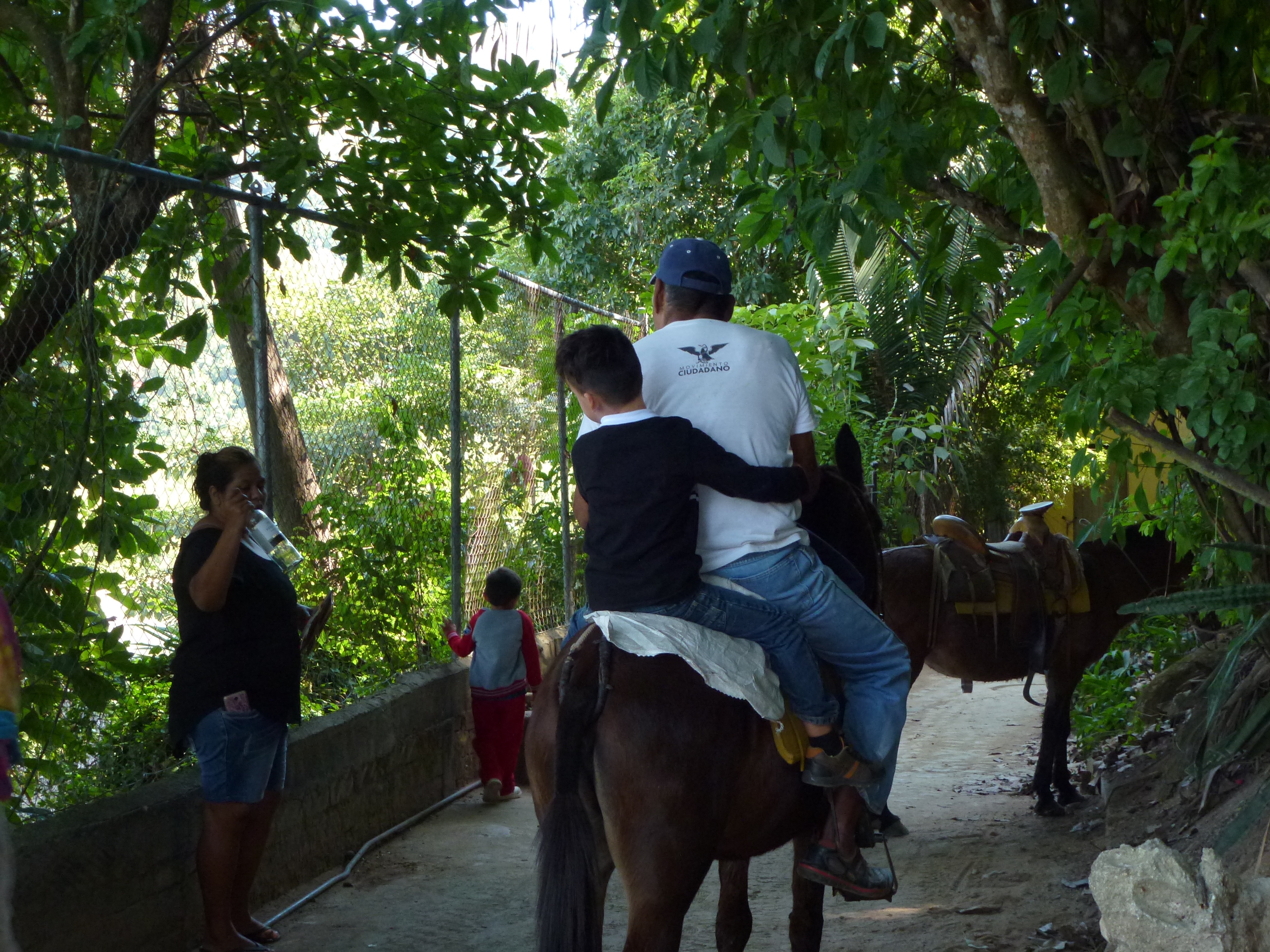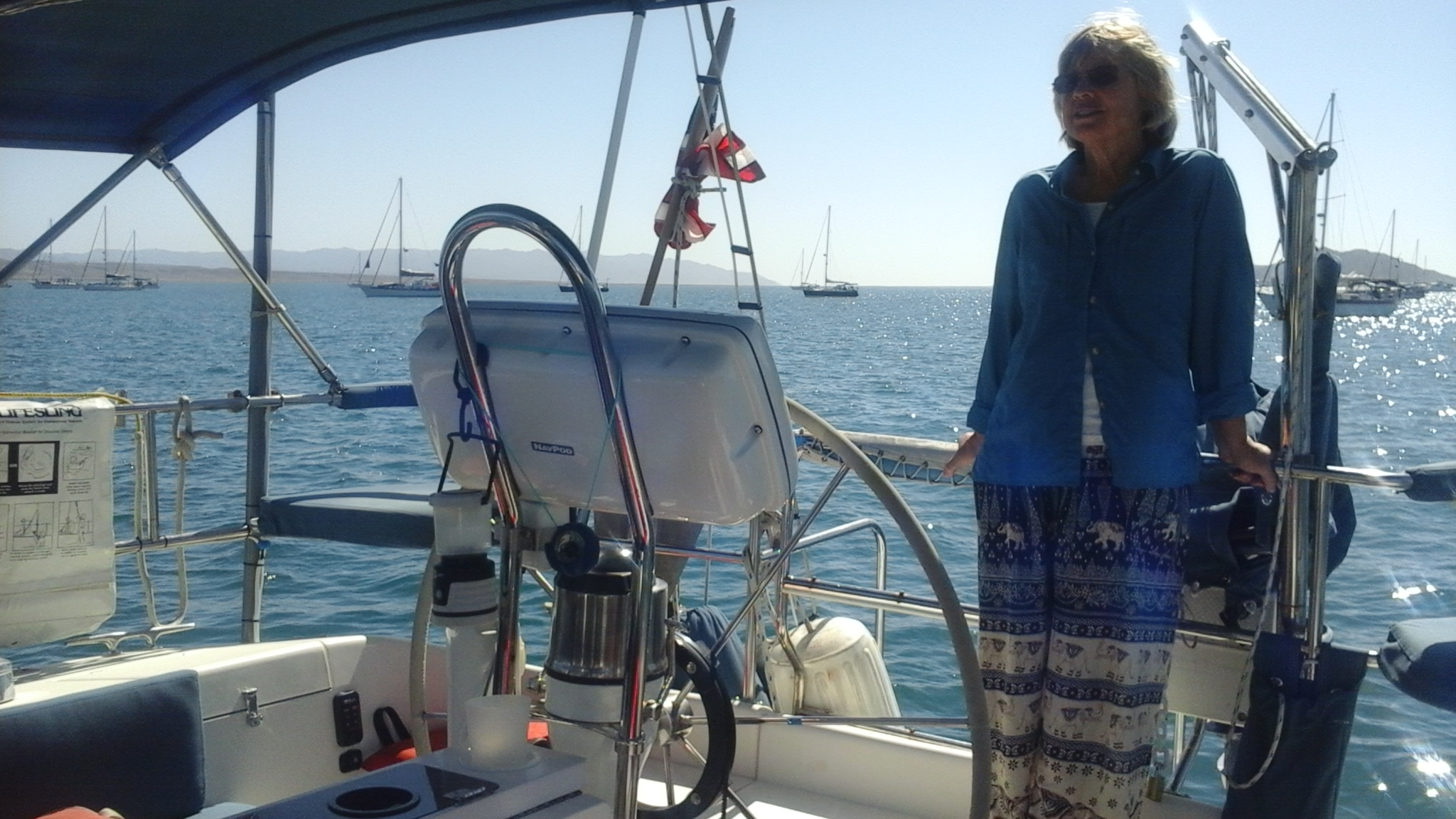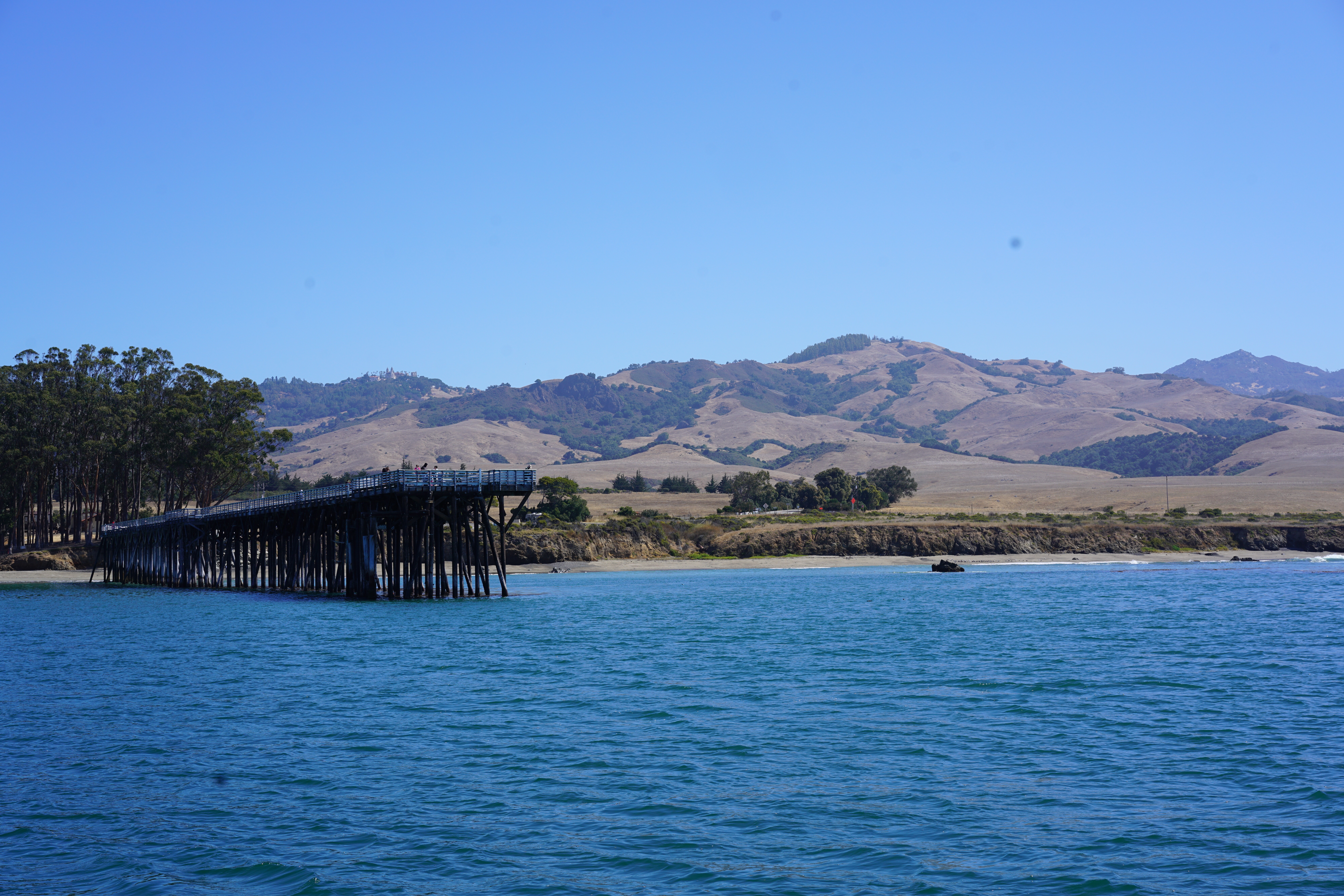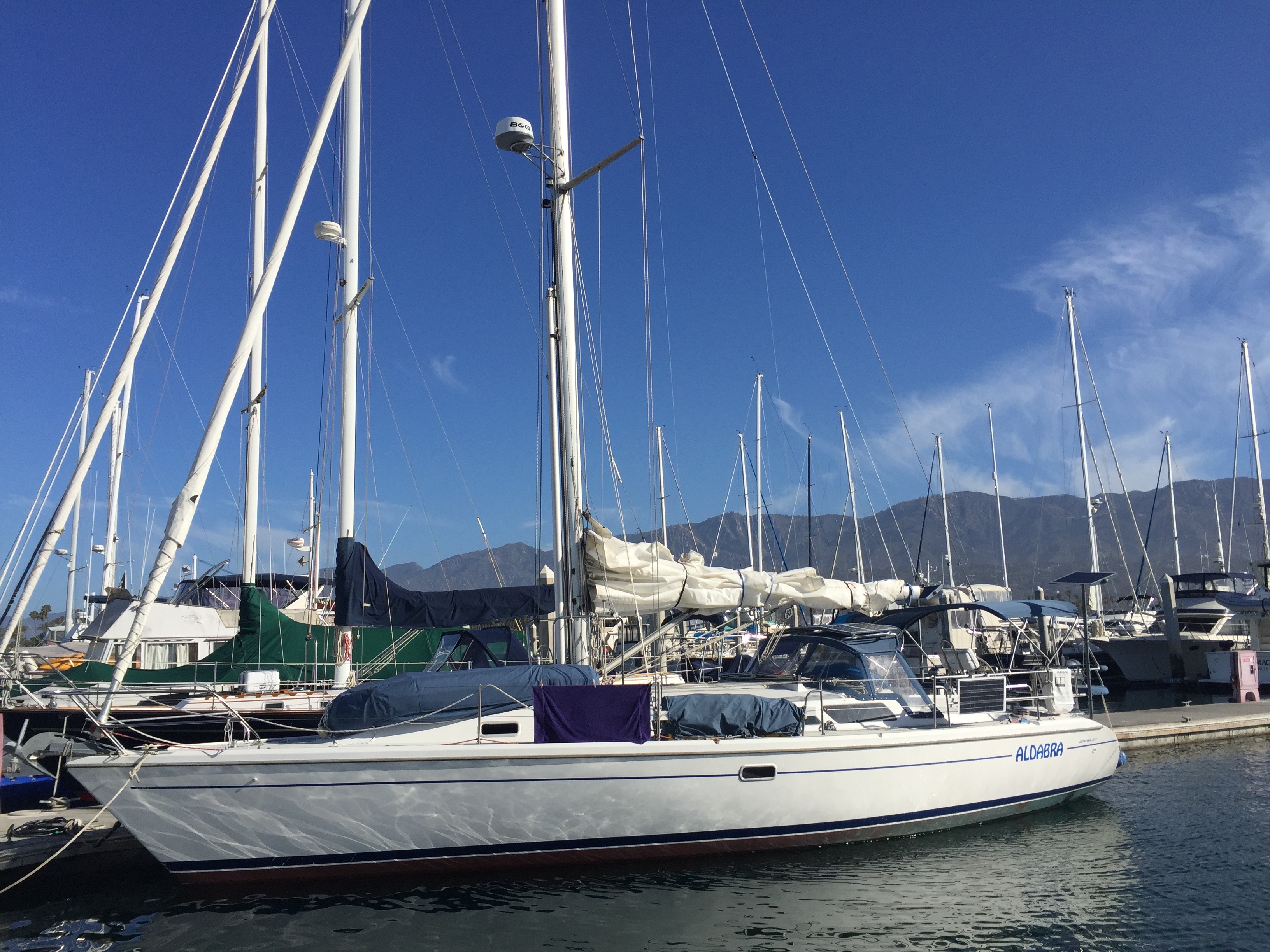We spent two days in Yelapa, which is south across Banderas Bay from La Cruz. There are no cars. Narrow cobblestone roads are used for walking, horseback and some used of small quads. There are lots of guest houses and various retreats. Also private palapas owned by gringos. Walking around the area, especially up the river and back is very picturesque. The beach is very touristy. People come in on boats for the day. But for those who stay for a few days, it looks like there is a night life with good food and music. The anchorage was really rolly. We were tied up to a mooring buoy at the bow and another one at the stern. But the wind direction shifts at night so the wind is pushing you one way and the swell pushing you another. It didn’t appear that there was a good place to land a dinghy so we used water taxis. But they are scarce after dark so staying on shore for the evening wasn’t an option unless one were to make some sort of prior arrangement. We returned from Yelapa to La Cruz on Thursday morning, December 8, in time for Ted to catch a flight back home.
We’re in a marina in the charming town of La Cruz de Huanacaxtle in Banderas Bay on Mexico’s Pacific Coast. Just like everywhere we’ve been since sailing over to the Pacific Coast from Baja, the cruisers are very welcoming, friendly and helpful.
We’ve met sailors who have sailed thousands of ocean miles as well as sailors who just like to live and sail in Mexico. It was especially fun to meet Jack on Fleetwood, who has until February to finish his circumnavigation before he turns 80.
We’ve been in La Cruz for a week. We left Chacala on Sunday night and arrived here before dawn on Monday. Rather than enter a strange marina in the dark, we anchored, got some sleep and entered the marina a little after nine. That afternoon we took a bus into Puerto Vallarta to a marine supply store, where I bought a new dinghy and motor to replace those stolen in Matanchen Bay. The new dinghy and motor were delivered to me at the marina the following day.
I plan to use La Cruz and Banderas Bay as a home port for the next several weeks. It’s good place to get some work done on the boat. And it’s good launching off spot to take a few short trips to other parts of the bay.
While in La Cruz we’ve enjoyed the street food and restaurants and the local Sunday crafts/food market. There are also lots of gatherings and activities among the cruisers and we have participated a bit. I’m looking forward to the Banderas Bay Blast, which is 3 days of casual racing coming up soon. In the mean time, we will head over tomorrow to the village of Yelapa, across the bay. We’ll stay a couple of days and then head back to La Cruz. It has been raining here so it’s a good time to take a little trip now that the weather has improved.
After leaving Mazatlan, we sailed overnight to Isla Isabel. We anchored for the day on the eastern side of the island, just off a beach with nesting blue-footed boobies and other sea birds. It was my first opportunity to snorkel since leaving San Diego. The water was clear with lots of reef fish. There were no other visiting boats.
That evening we sailed overnight to Matanchen Bay, south of San Blas. Matanchen is a large, shallow bay with very little activity, except for fisherman and their nets in the middle of the night. There was one other boat anchored in the bay when we arrived. After resting up, we took the dinghy up to San Blas. It was a long, wet ride but it was fun to check out the town and the marina. The next morning a couple of us took the dinghy up a nearby river on our own personal meandering jungle tour. We saw crocodiles and a variety of birds. That afternoon, Don and Anne arrived in the bay on Redwood Coast II. To celebrate Thanksgiving we had dinner together at a palapa on the beach. We were the only customers.
That night I stupidly failed to lock the dinghy to the boat, and someone cut the line and took the dinghy with motor, anchor, wheels and fuel tank. Don and Anne and I cruised the bay the next morning to see if the dinghy had been abandoned, but we saw no sign. We then pulled up the anchor and went into San Blas to make a report with the port captain and the police. After spending the night in the San Blas marina, we headed to Chacala and spent a couple of nights enjoying this small but vibrant beach town, popular with Mexican families. It was fun to sit under a thatched roof with dozens of families enjoying their beach day. Don and Anne were there as well and loaned us their spare dinghy.
We’re in Mazatlan right now at the El Cid marina. We arrived on Thursday, November 17 after crossing over to the Mexican mainland from San Jose del Cabo. The crew consisted of Dave and Ted and me. Dave has now left and we have been joined by Dax. We’ve got fuel, water, provisions and a working chart of Mexico, so we are ready to take off tomorrow. We’ll do one overnight sail and then stop at Isla Isabela, then head to San Blas and meander down the coast to Banderas Bay.
Thanks to Pat Crosthwaite for these pictures. I wish we had one of him in the collection. Just a few images of what the Baja HaHa was like. The first two days brought big seas and heavy air. The next leg had a variety of wind conditions. And the final leg had very light or no air. There was a little bit of everything on this trip, but what stands out more than anything is the teamwork on our boat and the supportive nature of the HaHa organizers and the entire fleet. Lots of things happened but people were quick to lend assistance. Quite a rewarding experience. And it continues as we get better acquainted with our fellow sailors in each port, even after the HaHa is over.
Aldabra was hauled out on Monday, September 12 for an inspection of thru hulls, cutlass bearing and rudder bearings. Also on the list were repacking the stuffing box, tuning the rigging, installing mast steps, servicing the engine and cleaning and waxing the hull. The rudder bearings and the cutlass bearing were deemed solid, but they’re replacing the cutlass bearing anyway, just because it may be 20 years old. And the thru hull valves were all lubricated.
The yard did a full inspection and we agreed that the shaft needed to be removed and sent to the machine shop for either repair or replacement. I’m waiting to hear which it will be. The rigger also did an inspection and will be making some adjustments to the boom, spinnaker pole and mast, along with the tuning and mast-step installation. Because of the delay caused by the shaft, I decided to have them paint the bottom and remove and replace the stripe and name on the hull. The bottom painting wasn’t due for another year, but this way I can forget about it for 3 years. After all the work is done, a marine surveyor will do a survey report, which is helpful for insurance and any marinas I visit.
While Aldabra is out of the water, my niece Emily and I have been installing netting inside the boat and buzzing around Shelter Island to break in the dinghy motor.
On Saturday morning, July 23, Chris and Julia and I stopped at the fuel dock and refilled the fuel tank and 5 jerry jugs with diesel before leaving the Santa Barbara Harbor bound for Santa Cruz Island. We sailed into southerly 10-15 knot winds and 3- to 4-foot swells. As the wind clocked around to being on the nose, we took in the jib and motor-sailed with the main. It was an uncomfortable ride across the Santa Barbara Channel but we were about an hour away and looking forward to exploring anchorages. That all changed when I slipped on a cockpit cushion and fell into the ignition key. I won’t describe the wound here but it was clear that it required serious medical attention. Most people will probably believe it’s a shark bite. Chris determined that the closest harbor was Santa Barbara so he turned the boat around while Julia and I compressed the wound with a sanitary pad and an Ace bandage. I held frozen food bags on the wound for the three and a half hours back to Santa Barbara.
Chris and Julia dropped the main before we re-entered the harbor. The accommodation dock was full so we tied up at the fuel dock, where Julia and I hopped off. Julia had researched hospitals during the trip back so she summoned an Uber car and we were off to the Santa Barbara Cottage Hospital ER. Meanwhile, Chris stayed with the boat on the fuel dock until they needed room. Once he had to leave, he did an amazing job of getting the boat to the slip and tied up, by himself.
At the hospital, they treated my wound, splinted and wrapped my leg and gave me lessons on using crutches, delivering the news that I would have to be off the leg for two weeks. The trauma doctor treated me on the condition that I would stick around Santa Barbara and return for a checkup in two days. The Southern California part of this trip had just changed from an adventure to a delivery. We would need to get the boat to San Diego without exploring the Channel Islands and without much visiting along the way. We returned to the harbor and Chris pulled me along the long dock to the boat on a rusty hand truck he found unattended near a fishing boat. We liked Santa Barbara and didn’t mind being back in the harbor but they could offer us the slip for only one more night.
The next day, we motored and sailed to Channel Islands Harbor in Oxnard, enjoying the balmy weather. Chris and Julia handled the boat easily as I sat with my leg elevated and made occasional suggestions. After we got situated in a slip, Chris and Julia found a good take-out pizza place nearby and we enjoyed a casual dinner on the boat, on a nice warm night, as people in kayaks, on paddle boards or in electric-powered Duffys cruised the channel.
First thing on Monday morning, Julia summoned another Uber driver and we headed to the Oxnard train station. We had a scenic train-ride back to Santa Barbara and a quick drive to the ER. The staff got me in for a checkup quickly and were pleased that I had followed instructions to stay off the leg. They exchanged the splint for a full-leg brace and sent me on my way. Julia and I returned to the train station after a nice lunch nearby and caught the 2 p.m. train back to Oxnard. When we returned to the boat, we discovered that Chris had been very productive. He had hand-washed his laundry in a bucket and had walked to West Marine and CVS to buy the parts to secure the cockpit cushions so no one else would slip on them. He also had enveloped the ignition key in foam.
On Tuesday, we motored in no wind, flat water and patchy fog toward Marina Del Rey. The fog cleared about the time we rounded Pt. Dume so we had a nice tour of the coastline.
We had made good time so for the last hour before entering the harbor we turned off the motor and sailed with just the jib. David and Susan Rose had arranged for a slip near their apartment in the marina and helped guide us in. The marina facilities were nice and David’s and Susan’s hospitality even better. They took us up to their apartment for showers and snacks and then out to Mexican dinner. It was a short visit but I’m hoping they can come to San Diego to sail with me when I can actually sail the boat.
On Wednesday we had a scenic trip from Marina Del Rey to Alamitos Bay. After motoring in light winds in the morning, we were able to sail with just the jib in 15-knot winds during the afternoon. We saw lots of dolphins but were never quite prepared with the cameras. We had expected to dodge big ships near the Port of Long Beach but only one ship went in while we were sailing through the area. All the other ships were anchored offshore. The wind made docking a bit of a challenge but after we were settled in, Julia’s parents (my sister Debbie and her husband John) arrived to take us to their house in nearby Huntington Harbor. We showered and had dinner and John drove Chris and me back to the boat for the night while Julia stayed home to do laundry and sleep in her bed for a night. I wondered whether Julia had had enough, but she returned the next morning with her father for the next leg, to Oceanside. We motored the whole way along the coast in light winds, past the long stretches of Huntington Beach and Newport Beach, then Laguna Beach, Dana Point, San Onofre, Camp Pendleton. It’s nice to see all these places from a different perspective.
We docked in Oceanside by mid-afternoon, relaxed on the boat for a bit, had dinner at the Jolly Roger, which was in front of our dock, and bid farewell to John, who caught a train back home. Early the next morning, my brother-in-law, Brian, brought my mother, sister Ann and niece Hannah to join us for the trip to San Diego. We again had to motor the whole way in light wind and 3-ft. swells. Although it would have been a lot nicer to sail, everyone enjoyed the tour of the an Diego County coast.
Navigating in the bay that day was tricky as one warship entered port and three left port at the same time. We dodged them and found the Sun Harbor Marina. We were disappointed to discover that the marina has a very narrow fairway and many of the boats stick way out. Getting into the slip was harrowing as Chris backed up and went forward a dozen times while the rest of us fended off near collisions with other boats. I’m not sure how I’m going to get the boat in and out to go sailing. I may just leave the boat in the slip for the first month while I get projects done.
Aldabra is now buttoned up in the marina. Julia has returned to Huntington Harbor and Chris has returned to Santa Cruz. I’m staying at my mother’s house in San Diego and visiting with my family while counting the days (6) before I can move around without crutches.
We left Santa Cruz mid-morning of Monday, July 18. The crew was Jim Foley, Chris Bryant and my niece Teela Crosthwaite Smith. We sailed over to Stillwater Cove for a look, then continued on past Carmel Beach and on down to Point Sur.
The sail was pretty mellow until well past Point Sur. At that point the northwest winds picked up and the swell was large. Around 8 p.m. the trip became quite lively, and continued to challenge us until we passed Piedras Blancas.
We were then motoring in light wind, patchy fog and decreasing swell. We arrived in San Simeon Bay at 4:00 a.m.
We anchored, got 4 hours of sleep, then puttered about the boat before continuing to Port San Luis. The sail to Port San Luis was variable, always big swells but sometimes light wind, sometimes more intense wind.
We sailed for several hours with a jib on the spinnaker pole, but to pass Pt. Buchon in light winds and large swells, we ended up motoring. We arrived in Port San Luis at 7:00 p.m. and the port had flat water and a welcome warm wind. We had a lovely dinner, a good sleep and worked on some plumbing when we woke up in the morning. We then left for Coho. The sail past San Luis Obispo Bay was steady and things didn’t intensify until rounding Pt. Arguello and Point Conception. Between those two points, the wind slackened and the swells grew. Teela entertained us with information at all points along the coast but we were particularly intrigued with the story of the 1923 Honda Point disaster as we passed Arguello. We had never heard of this incident, where 7 naval vessels were lost and 23 sailors died when they mistook Pt. Arguello for Pt. Conception. Fourteen ships were navigating by dead reckoning at 20 knots in heavy fog. We did end up motoring a bit around Pt. Conception and into Cojo. We anchored easily in Cojo and had a pleasant evening.
The trip from Cojo to Santa Barbara brought some steady winds, some light winds and subsiding swells. We tried out our double-jib configuration (with one jib on the pole and one attached to the boom), and also tried out the spinnaker for the first time.
When we arrived in Santa Barbara, we checked in, got a slip, took showers, had dinner in a restaurant on shore and had another good night’s sleep.
The next morning. Jim and Teela left us to travel back north by train. My niece Julia Staudinger arrived to join us, and we took off again the next day for points south.
This shot was taken as I was doing some work halfway up the mast. You can see several of Aldabra’s solar panels. There are also two more on the rails that are folded down at the moment. We’re pretty sure these panels will handle most of my electrical needs. You can also see on the deck the yellow jugs for extra diesel fuel (and one red for gasoline) that will be stored on the deck because there is never enough storage inside a boat.








































